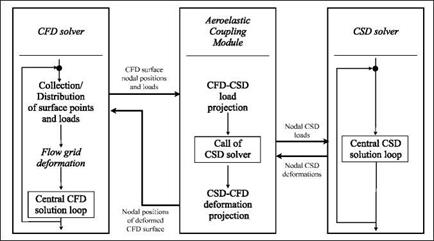A Comparison of Fluid/Structure Coupling Methods for Reduced Structural Models
Georg Wellmer, Lars Reimer, Horst Flister, Marek Behr, and Josef Ballmann
Abstract. In this paper, the realisation and testing of spatial coupling methods for aeroelastic simulations with partitioned algorithms is presented. The investigated methods for spatial coupling—the transfer of loads and deformations between the wetted surface and the structural model—are the method of Finite Interpolation Elements and two other, newly-implemented interpolation methods. All three are suitable for reduced structural models, and the geometries of the wetted surface and the structural model do not have to coincide. The aeroelastic simulation tool employed and the theoretical background of the spatial coupling schemes are outlined. Different measures for the quality of the spatial coupling are derived and applied to test cases of increasing complexity. The influence of user-defined coupling parameters on the deformation projection is assessed. Based on these results and on practical considerations, the available coupling methods are compared and conclusions are drawn regarding their applicability.
1 Introduction
The civilian aircraft industry faces the necessity to reduce aircraft fuel consumption while increasing flight safety levels and maintaining passenger comfort. Furthermore, competition on the aircraft market forces manufacturers to accelerate design cycles and to reduce the costs of the actual development. This twofold pressure has brought about the widespread adoption of numerical prediction methods during all
Marek Behr • Georg Wellmer • Lars Reimer
Chair for Computational Analysis of Technical Systems (CATS), Center for Computational Engineering Science (CCES), RWTH Aachen University, SchinkelstraBe 2, 52062 Aachen e-mail: {wellmer, reimer, behr}@cats. rwth-aachen. de
Josef Ballmann
Lehr – und Forschungsgebiet fur Mechanik (LFM), RWTH Aachen University,
SchinkelstraBe 2, 52062 Aachen
e-mail: ballmann@lufmech. rwth-aachen. de
B. Eisfeld et al. (Eds.): Management & Minimisation ofUncert. & Errors, NNFM 122, pp. 181-218. DOI: 10.1007/978-3-642-36185-2_8 © Springer-Verlag Berlin Heidelberg 2013
stages of the design process. Computational Fluid Dynamics (CFD) for the numerical prediction of the flow field about aircraft configurations are of special interest to the industry. These methods have matured to a point where they are not merely complementing costly wind tunnel test campaigns, but actually partially supplanting them. Simultaneously, improvements in structural analysis methods such as Computational Structural Dynamics (CSD) and in material sciences have led to lighter aircraft frames with greater inherent elasticity. Aeroelastic coupling effects now definitely have to be considered in the design process and thus also have to be captured by the numerical prediction methods, i. e. by Computational Aeroelasticity (CAE) solvers. A code package for the simulation of the interaction between aerodynamic, elastic and inertial forces has been developed at LFM/CATS over the last decade. Work was initiated at LFM within the framework of the Collaborative Research Centre 401 (SFB 401) [3, 28] and continued at CATS, in the course of the collaborative research project MUNA, amongst others.
In order for CAE to gain the same acceptance in the aerospace community as that already enjoyed by CFD, its solutions must prove to be trustworthy. Engineers require the numerical predictions design decisions are based on to have a dependable accuracy, which can be evaluated in two different manners: First of all, by comparison with experimental results the error incurred by the whole coupled algorithm can be estimated. It can then be used as a measure of confidence for numerical predictions regarding comparable configurations. Validation against steady and unsteady wind tunnel data has been carried out continuously at LFM/CATS, most recently in the project “High Reynolds Number Aero-Structural Dynamics” (HIRENASD) [4, 24]. This approach has the downside that without extensive parameter studies the cause of deviations—potentially each of the single-field
|
Fig. 1 General concept of the ACM and its data exchange with the CFD and CSD solvers (taken from [28]) |
solvers or their mutual interaction—cannot be easily determined. Besides, it must not be forgotten that also measurements inevitably have an error. In the second approach error sources are identified and examined individually, at least as far as such a separation is possible. Regarding aeroelastic coupling, it has to be demonstrated that associated sources of error do not significantly impair the accuracy of the overall coupled solution. This method often is feasible for model test cases only, and the findings have to be scrutinised before being applied to real-world problems. During the MUNA project both outlined investigation methods have been applied at LFM/CATS with regard to steady aeroelastic simulations and their associated error sources.
This paper will take the following outline: First the coupling methodology in general and the algorithm developed at LFM/CATS in particular are delineated, as well as the available spatial coupling methods. The potential error sources are defined and their influence is quantified for model problems. Next, the assessment is repeated for actual coupled flow simulations. Based on the results, the available methods for spatial coupling are compared and a set of recommendations is derived.












